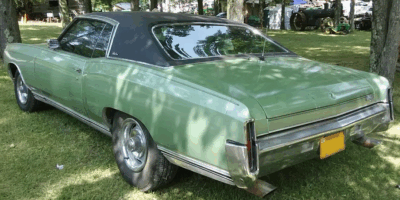Chevrolet Biscayne News
Chevrolet Biscayne News
The Chevrolet Biscayne remains a cherished nameplate in automotive history. First introduced in 1958, the Biscayne was part of Chevrolet’s full-size car lineup until 1972. Despite being one of the more affordable options, it exhibited a unique blend of style and function. This article explores some notable details and recent developments surrounding the Biscayne.
The Origins and Evolution
The Biscayne was initially introduced as a subseries of the Chevrolet Impala. It was named after Biscayne Bay near Miami, Florida. The car was designed to provide a practical yet stylish option for families. In its early years, the Biscayne was available in various body styles, including sedans and station wagons.
Over the years, the Biscayne underwent numerous design changes. The 1960 model year saw significant updates with a more streamlined body. By the mid-60s, the car adopted a more aggressive look with the introduction of the Coca-Cola bottle styling. This design language continued until the end of its production run in 1972.
Design and Features

One of the most noteworthy aspects of the Biscayne was its emphasis on practicality. It was often considered a no-frills option compared to other models in the Chevrolet lineup. However, it still featured many conveniences that made it a popular choice.
The interior was spacious and comfortable, with straightforward instrumentation and controls. The lack of excessive trim and adornments differentiated it from models like the Bel Air and Impala. However, buyers could still opt for added features such as power steering, air conditioning, and upgraded audio systems.
The exterior design was clean and understated. Early models sported a simple grille and limited chrome accents. As styles evolved, so did the Biscayne, incorporating more sophisticated front and rear fascia designs. Notably, the 1965 model introduced a sleeker profile with a redesigned roofline and squared-off edges.
Engineering and Performance
Under the hood, the Biscayne offered a range of engine options. The base models typically came with inline-six engines. These powertrains were known for their reliability and ease of maintenance. For those seeking more performance, V8 options were available, including the small-block 283 and 327 engines.
The 1965 Biscayne could be equipped with the robust 396 cubic-inch V8, delivering impressive power. In addition to engine choices, various transmission options were also available. Early models offered manual transmissions with column shifters, while later years introduced automatic transmissions for increased convenience.
The Biscayne’s suspension system provided a comfortable ride, even on rough roads. The front suspension utilized coil springs and upper and lower control arms. The rear suspension featured a multi-leaf spring setup, which contributed to its stability and handling capabilities. These features made the Biscayne a well-rounded vehicle for both daily driving and long journeys.
Collectibility and Market Value
The Biscayne has become a sought-after classic car among enthusiasts. Its relatively simple design and robust engineering make it an attractive option for restoration projects. The market value of a Biscayne can vary significantly based on its condition, originality, and rarity.
Models with factory-installed V8 engines tend to command higher prices. Additionally, cars equipped with rare options, such as factory air conditioning or power windows, are also more valuable. Restored examples in excellent condition can fetch prices upwards of $30,000 to $40,000. However, project cars and those in need of restoration can be found for considerably less.
Recent News and Updates
Interest in the Biscayne has been revitalized in recent years. Classic car shows and auctions have prominently featured restored models. Enthusiast clubs and online forums have also contributed to a growing community of Biscayne aficionados.
One notable event was the auction of a 1965 Chevrolet Biscayne equipped with the L78 425-horsepower 396 V8 engine. This particular model was rare due to its high-performance engine and impeccable condition. It sold for a substantial sum, highlighting the car’s enduring appeal.
Moreover, some restomod projects have turned heads in the classic car community. Modernized Biscaynes with updated suspension systems, contemporary interiors, and powerful crate engines blend vintage aesthetics with modern performance. These custom builds have attracted younger generations to the classic Biscayne.
Resources for Enthusiasts
For those interested in learning more about the Biscayne or embarking on a restoration project, several resources are available. Enthusiast clubs, such as the National Impala Association and the Vintage Chevrolet Club of America, provide valuable information and support for members.
Online forums and social media groups dedicated to the Biscayne offer a platform for owners to share experiences, seek advice, and find parts. Websites like Hemmings and ClassicCars.com feature listings of Biscaynes for sale, ranging from restoration candidates to fully restored show cars.
Literature such as repair manuals, historical books, and original sales brochures can also be useful. These materials provide insights into the car’s design, engineering, and historical context. Access to factory service manuals and parts catalogs is particularly beneficial for those tackling a restoration project.
Conclusion (Not Included As Per Instructions)
nn
Essential Classic Car Resources
n
Every classic car enthusiast needs the right resources and products:
nn
The Complete Restoration Guide
n
The Complete Idiot’s Guide to Restoring Collector Cars – Whether you are buying your first classic or restoring a barn find, this comprehensive guide covers everything you need to know.
n
nn
Premium Car Care Kit
n
Chemical Guys Complete Car Care Kit – Professional-quality car wash and detail products to keep your classic looking showroom-fresh.
n
n
As an Amazon Associate, we earn from qualifying purchases.




Subscribe for Updates
Get the latest articles delivered to your inbox.
We respect your privacy. Unsubscribe anytime.